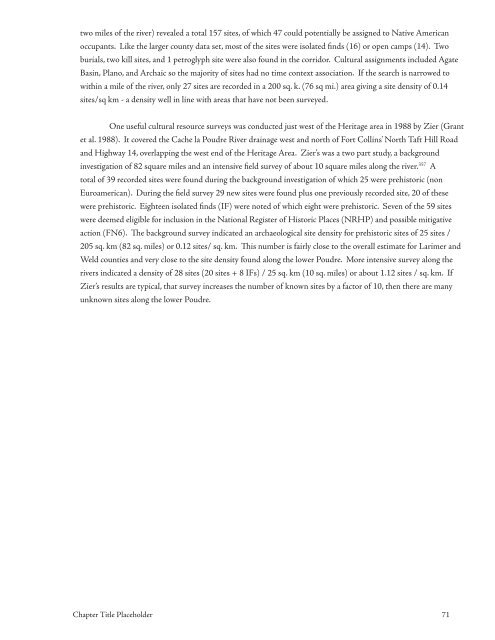Appendix - Archaeological survey detailsThis appendix takes a closer look at <strong>the</strong> nature <strong>of</strong> <strong>the</strong> archaeological sites recorded in Larimer and Weldcounties based on a February 2006 search <strong>of</strong> <strong>the</strong> Colorado Office <strong>of</strong> Archaeology and Historic Preservationdatabase. Figure A.1 shows site break down by time period. Many sites had multiple time attributions showingsite reuse over time. Figure A.2 shows <strong>the</strong> site break down by type <strong>of</strong> site. Most <strong>of</strong> <strong>the</strong> “sites” are seen to iso<strong>la</strong>tedfinds although open lithic (a site with multiple pieces <strong>of</strong> stone tool debris) and open camp sites in combination arealmost as frequent. Here, too, a pattern <strong>of</strong> multiple use <strong>of</strong> sites is seen since all strictly Euroamerican content siteswere removed (barbed wire, g<strong>la</strong>ss ware, concrete, ditches, railroad, transmission line, etc). The chart shows a highnumber <strong>of</strong> trash dumps and historic sites that were created by Euroamericans. Figure A.1. Site breakdown Figure A.2. Type <strong>of</strong> site bar chartFigure A.3shows <strong>the</strong> distribution <strong>of</strong> sites by township/range designation. The cells are shaded bywhe<strong>the</strong>r <strong>the</strong> number <strong>of</strong> sites in <strong>the</strong> block is smaller than <strong>the</strong> average -20 ± 1 sites assuming a block is about 100sq. km. Bold numbers show <strong>the</strong> cells that contain <strong>the</strong> <strong>Poudre</strong> River. The highest number in any <strong>of</strong> <strong>the</strong> cells is179 (at T8N, R61W) near Stoneham, an area that has seen significant archaeological investigation by <strong>the</strong> RobertBrunswig and <strong>the</strong> University <strong>of</strong> Nor<strong>the</strong>rn Colorado. O<strong>the</strong>r well surveyed areas include <strong>the</strong> Pawnee Grass<strong>la</strong>nds(T8N-T10N, R63W-R66W), Rocky Mountain <strong>National</strong> Park (T4N-T7N, R73W-R74W), <strong>the</strong> confluence<strong>of</strong> <strong>the</strong> <strong>Poudre</strong> and North <strong>Poudre</strong> (T8N, R70W), and <strong>the</strong> Box Elder drainage (T9N-T12N, R70W). Lookingat <strong>the</strong>se areas, it seems that when an area gets surveyed we find a lot <strong>of</strong> sites. It can also be seen that <strong>the</strong> rivercorridor has only one block with an above average number <strong>of</strong> sites. This block happens to be <strong>the</strong> one in whicha good chunk <strong>of</strong> Fort Collins sits. Construction activity is likely exposing <strong>the</strong>se sites. Looking at this picture atarms length, <strong>la</strong>rge patches <strong>of</strong> green correspond to areas <strong>of</strong> prior survey work with a lot <strong>of</strong> yellow in between. Clearpatterns such as <strong>the</strong> west half <strong>of</strong> <strong>the</strong> picture (mountain area) with lots <strong>of</strong> sites and <strong>the</strong> east (p<strong>la</strong>ins area) without,or lots <strong>of</strong> sites along drainages and none on <strong>the</strong> up<strong>la</strong>nds, do not appear. Generally, all areas <strong>of</strong> Larimer and Weldcounty have seen use by people in <strong>the</strong> past and <strong>the</strong>se people have left visible indications <strong>of</strong> that usage. Figure A.3 A grid chart showing township and range numbersSummarizing what <strong>the</strong>se three pictures suggest in aggregate:• <strong>People</strong> have left evidence <strong>of</strong> <strong>the</strong>ir use <strong>of</strong> Larimer and Weld counties for over 12,000 years and <strong>the</strong>evidence has accrued at a on-going rate.• Occupation has been distributed across <strong>the</strong> counties, and because <strong>the</strong> sites are mostly iso<strong>la</strong>ted findsand small camps was probably <strong>of</strong> a short-term nature.• Since most sites can’t be assigned to a particu<strong>la</strong>r culture group based on what <strong>the</strong>y left behind, itmay mean that how <strong>the</strong>y used Larimer and Weld counties didn’t change much over time or space.Looking in more detail at <strong>the</strong> sites that have been recorded within <strong>the</strong> <strong>Heritage</strong> <strong>Area</strong> (sections within70 <strong>People</strong> <strong>of</strong> <strong>the</strong> <strong>Poudre</strong>
two miles <strong>of</strong> <strong>the</strong> river) revealed a total 157 sites, <strong>of</strong> which 47 could potentially be assigned to Native Americanoccupants. Like <strong>the</strong> <strong>la</strong>rger county data set, most <strong>of</strong> <strong>the</strong> sites were iso<strong>la</strong>ted finds (16) or open camps (14). Twoburials, two kill sites, and 1 petroglyph site were also found in <strong>the</strong> corridor. Cultural assignments included AgateBasin, P<strong>la</strong>no, and Archaic so <strong>the</strong> majority <strong>of</strong> sites had no time context association. If <strong>the</strong> search is narrowed towithin a mile <strong>of</strong> <strong>the</strong> river, only 27 sites are recorded in a 200 sq. k. (76 sq mi.) area giving a site density <strong>of</strong> 0.14sites/sq km - a density well in line with areas that have not been surveyed.One useful cultural resource surveys was conducted just west <strong>of</strong> <strong>the</strong> <strong>Heritage</strong> area in 1988 by Zier (Grantet al. 1988). It covered <strong>the</strong> <strong>Cache</strong> <strong>la</strong> <strong>Poudre</strong> River drainage west and north <strong>of</strong> Fort Collins’ North Taft Hill Roadand Highway 14, over<strong>la</strong>pping <strong>the</strong> west end <strong>of</strong> <strong>the</strong> <strong>Heritage</strong> <strong>Area</strong>. Zier’s was a two part study, a backgroundinvestigation <strong>of</strong> 82 square miles and an intensive field survey <strong>of</strong> about 10 square miles along <strong>the</strong> river. 357 Atotal <strong>of</strong> 39 recorded sites were found during <strong>the</strong> background investigation <strong>of</strong> which 25 were prehistoric (nonEuroamerican). During <strong>the</strong> field survey 29 new sites were found plus one previously recorded site, 20 <strong>of</strong> <strong>the</strong>sewere prehistoric. Eighteen iso<strong>la</strong>ted finds (IF) were noted <strong>of</strong> which eight were prehistoric. Seven <strong>of</strong> <strong>the</strong> 59 siteswere deemed eligible for inclusion in <strong>the</strong> <strong>National</strong> Register <strong>of</strong> Historic P<strong>la</strong>ces (NRHP) and possible mitigativeaction (FN6). The background survey indicated an archaeological site density for prehistoric sites <strong>of</strong> 25 sites /205 sq. km (82 sq. miles) or 0.12 sites/ sq. km. This number is fairly close to <strong>the</strong> overall estimate for Larimer andWeld counties and very close to <strong>the</strong> site density found along <strong>the</strong> lower <strong>Poudre</strong>. More intensive survey along <strong>the</strong>rivers indicated a density <strong>of</strong> 28 sites (20 sites + 8 IFs) / 25 sq. km (10 sq. miles) or about 1.12 sites / sq. km. IfZier’s results are typical, that survey increases <strong>the</strong> number <strong>of</strong> known sites by a factor <strong>of</strong> 10, <strong>the</strong>n <strong>the</strong>re are manyunknown sites along <strong>the</strong> lower <strong>Poudre</strong>.Chapter Title P<strong>la</strong>ceholder 71


